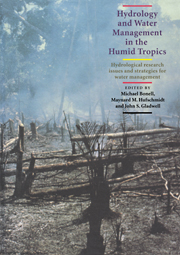 Hydrology and Water Management in the Humid Tropics
Hydrology and Water Management in the Humid Tropics Published online by Cambridge University Press: 23 December 2009
ABSTRACT
This chapter outlines some of the issues involved in erosion and sedimentation and the major approaches adopted by research investigators in dealing with them. Particular emphasis is given to recent developments in quantitatively describing soil erosion and deposition processes, and to elucidating the consequences of such description in the form of comprehensive mathematical models. How such models are used in practice to assess soil erodibility and depositability is illustrated, using data collected at the scale of runoff plots.
Approaches to investigating and representing erosion and deposition at the scale of catchments are also reviewed, although somewhat more briefly.
INTRODUCTION
Scientific study of soil erosion by water has a long history in the geographic and geomorphic sciences, where much of the emphasis is on erosion as one of the natural landscape-forming processes. Human activity, and especially the widespread and expanding activities of agriculture, has led to an acceleration of soil erosion commonly associated with agricultural practices. It is not surprising, therefore, to find that early agriculturally- focused research on soil erosion depended on successful agronomic research methodologies. These methodologies were typified by planned experimentation followed by quantitative (often statistically guided) analysis of the results obtained.
Following a significant period in which this fruitful agronomic type of approach has proved useful, research personnel now appear to be commonly using alternative methodologies in which more call is being made on physical theory to provide a framework in which experimental data are analysed. In this approach, parameters, which still have to be experimentally determined, are sought which are more closely related to the processes believed to be importantly involved in erosion and deposition.
To save this book to your Kindle, first ensure [email protected] is added to your Approved Personal Document E-mail List under your Personal Document Settings on the Manage Your Content and Devices page of your Amazon account. Then enter the ‘name’ part of your Kindle email address below. Find out more about saving to your Kindle.
Note you can select to save to either the @free.kindle.com or @kindle.com variations. ‘@free.kindle.com’ emails are free but can only be saved to your device when it is connected to wi-fi. ‘@kindle.com’ emails can be delivered even when you are not connected to wi-fi, but note that service fees apply.
Find out more about the Kindle Personal Document Service.
To save content items to your account, please confirm that you agree to abide by our usage policies. If this is the first time you use this feature, you will be asked to authorise Cambridge Core to connect with your account. Find out more about saving content to Dropbox.
To save content items to your account, please confirm that you agree to abide by our usage policies. If this is the first time you use this feature, you will be asked to authorise Cambridge Core to connect with your account. Find out more about saving content to Google Drive.